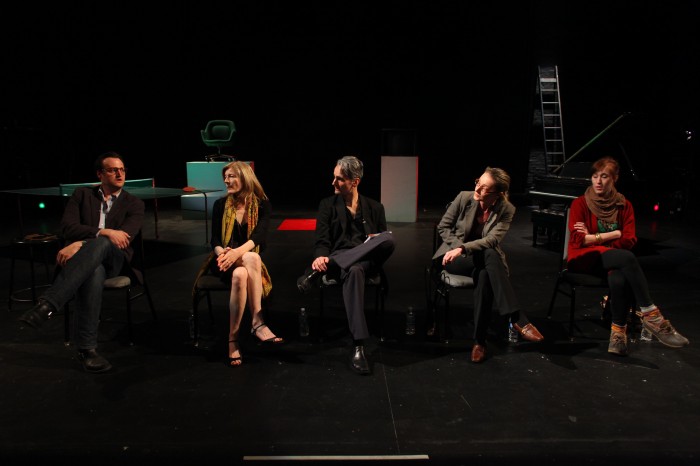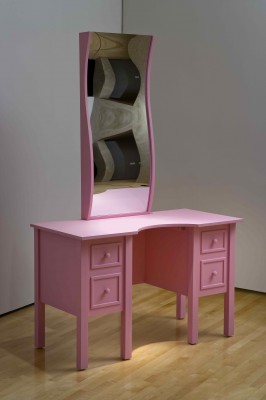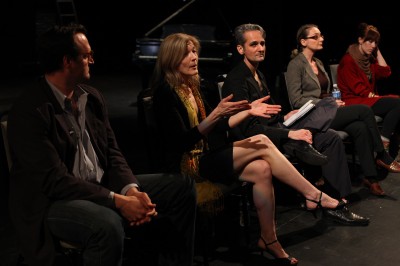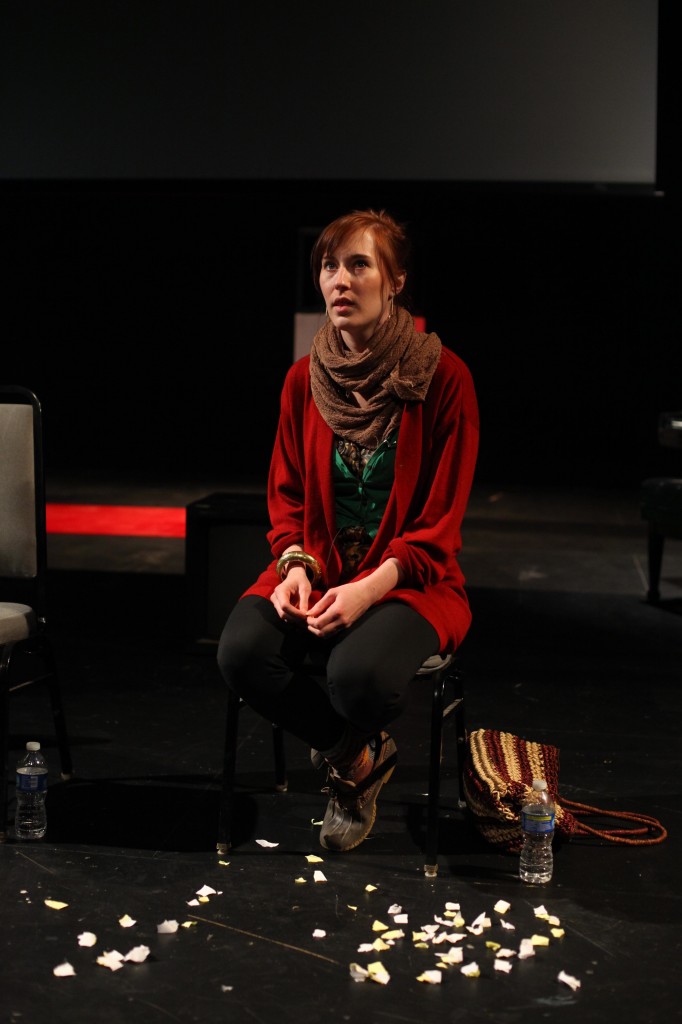The Juvenal Players (2009)
The Juvenal Players was a project consisting in fabricating a full retrospective of a fictional artist, Juvenal Merst, along with a public event discussing his work. The original project was commissioned, produced, and presented by Grand Arts in Kansas City in the summer of 2009, and was later presented at The Kitchen in 2010. Professional actors embodied the lives of fictional characters who supposedly were part of the artist’s life and were part of a symposium the day after the opening of the exhibition discussing Juvenal’s work. At the symposium the panelists start arguing over the artists life and work, and the event quickly devolves into a bitter argument about the past. The supposed panel discussion, now unmasked as a play, ends with a theater monologue by one of the actors on the pains that art inflicts.
Audience Commentary – David Kateforis
I am a professor of American, modern, and contemporary
art at the University of Kansas. I believe I possess a strong
knowledge of the canonical history of post-World War
II art, especially in New York, a city which I visit once
or twice a year. I attended the premiere performance of
The Juvenal Players at Grand Arts in Kansas City on the
afternoon of June 13, 2009. I came to the performance
having read the preview article by Alice Thorson in the
Kansas City Star (June 7, 2009), which gave me some
background information about Pablo Helguera.
Based on
what I read in Thorson’s article and on the Grand Arts
website, I had the strong sense that Juvenal Merst was
not an actual person but the creation of Helguera. (That
sense was confi rmed defi nitively once the “panel discussion”
commenced and one of the panelists indicated that
Merst had exhibited in prominent international biennials,
which I knew could not be true since I had never heard of
him.) Before the performance began I perused the works
of Juvenal Merst on display at Grand Arts and was deeply
impressed by their thoroughly professional (by art world
standards) level of conception, execution, and interpretation
(through an exhibition checklist, didactic wall labels,
and a hand-out with an introduction by Pablo Helguera
and an essay, “Juvenal Merst: The Inverted Compass,” by
Sonja Stillman, one of the panelists.) Clearly a person with
a deep knowledge of the conventions and pretensions of
the New York-centric contemporary art world and with a
razor-sharp intellect, potent wit, and superb literary talent
had created this elaborate fiction, which achieved a high
degree of verisimilitude in its deadpan mimicry of the body
of work of an actual contemporary artist. It also occurred
to me that only someone with an equally professional
knowledge of the contemporary art world would be able
to appreciate how well this was done.
Now, to the play: The audience found seats and the
panelists took the stage and it was announced that a
discussion would precede the performance of the play. I
soon realized that the discussion WAS the play and that
the panelists had been scripted to represent—not in a
one-dimensional but in a complex way—various types of
individuals (e.g., the preening critic, the self-important
curator, the wealthy but vapid patron, the failed or insecure
artist) who operate within the art world. I also quickly
realized that the actors were VERY good—these must be
top-notch New York actors, I thought to myself—their
projection of credible personae was as professionally
accomplished as were the faux works of Merst that surrounded
them. (I was even more impressed when I later
learned that these actors did not know much about the
art world before working on this play, and yet managed
to inhabit their roles completely and with absolute
conviction.) I remember thinking, as the play unfolded,
how much more satisfying it is to watch well-trained
and highly skilled actors perform a well-written play
than it is to watch a stereotypically amateurish piece of
“performance art” by an artist who lacks professional acting
skills and a good script. I also remember wondering
how these (presumably) New York actors felt—and how
Helguera felt—to be premiering this ambitious New-Yorkart-
world-centric play before a small audience in Kansas
City—a city that I know many New Yorkers consider a
provincial cow town. And I remember thinking also that,
ironically, it was a Kansas City institution, Grand Arts,
that made this New York-centric art work possible (as it
has others by internationally prominent artists such as
Isaac Julien, Alfredo Jaar, and Allan McCollum).
As I watched the play I noticed the actors making eye
contact with the audience and sensing our presence. There
was a palpable sense of intimacy between the performers
and the audience, as if this were a real panel discussion
and as if at any moment someone from the audience might
raise her hand and ask a question (I was tempted to do
this myself but refrained—not wanting to spoil Helguera’s
carefully crafted work). Unlike a normal panel discussion,
which typically retains a fi rm sense of decorum even when
panelists disagree, the Juvenal Players frequently argued
openly and made cutting and accusatory remarks to one
another. These elicited laughter from the audience; I’m
sure I was one of those laughing most loudly. This had a
cathartic eff ect.
After getting a sense of the defi ning values and role of
each character I found myself listening in their lines for
something—anything—that I could recognize as having
truth—at least to me—beyond its status as a satirical comment
on some convention or pretension of the involuted art
world and its inhabitants. The line I remember somehow
fi nding most meaningful was that of the patron, Rosaura,
who said at one point, “This is just art.”
Near the end of the play, after all the other characters
had left the stage, Miranda Saks remained, standing before
the table, to deliver a closing soliloquy, illuminated by a
spotlight, which transformed the heretofore naturalistically
presented panel discussion into a theater piece, unveiling
definitively its fictional nature.
I remember wondering why
Helguera made this directorial decision—why change the
nature of the piece at that point? Maybe to underscore the
point made earlier by Rosaura: “This is just art.” That to
me is the bottom line of the entire Juvenal Merst project
(a truly brilliant satire in the maximally ambitious form of
a Gesamtkunstwerk incorporating every person and object
in the space), and a line that I see as a challenge: surely
there is some art with real, even profound, meaning and
value that simply can’t be satirically dismissed.
David Cateforis
Lawrence, Kansas
July 20, 2009
Tags: Art Market, artworld., Fiction, Performance, Performance lectures, Sociology of art



